Report on Contemporary Issues in Management and Leadership
VerifiedAdded on 2024/05/31
|17
|3906
|473
Report
AI Summary
This report delves into contemporary issues in management and leadership, analyzing the qualities of a good manager and leader, exploring effective employee motivation strategies, and examining the structure, advantages, and challenges of self-managed organizations. It discusses the importance of leadership, communication, self-motivation, confidence, and planning for effective management. The report also contrasts the roles and responsibilities of managers and leaders, emphasizing the need for vision, inspiration, and adaptability. Furthermore, it assesses the potential benefits and drawbacks of organizations without traditional hierarchical structures, focusing on productivity, creativity, and decision-making processes. The report concludes by addressing potential problems in self-managed environments and suggesting solutions for effective operation.
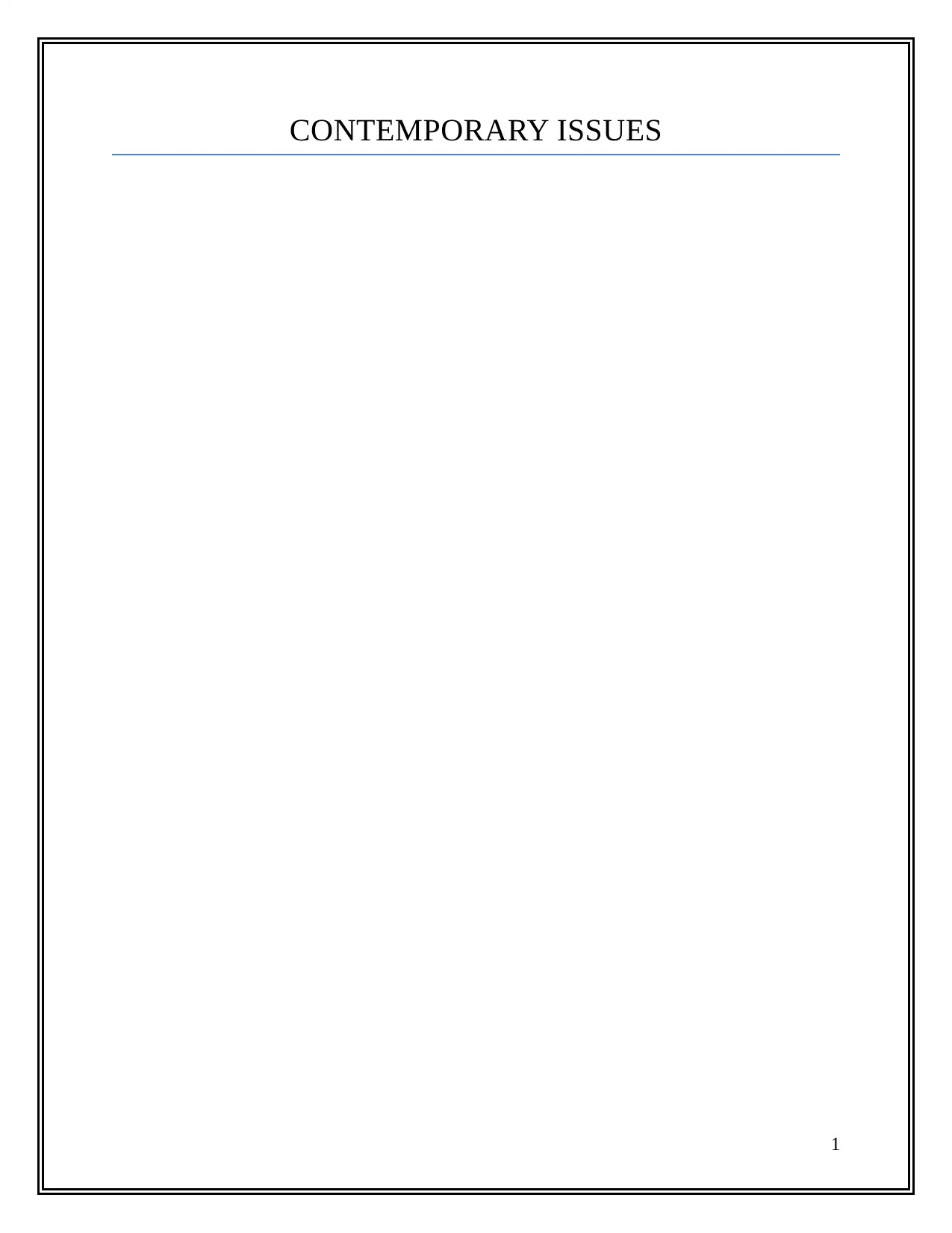
CONTEMPORARY ISSUES
1
1
Paraphrase This Document
Need a fresh take? Get an instant paraphrase of this document with our AI Paraphraser
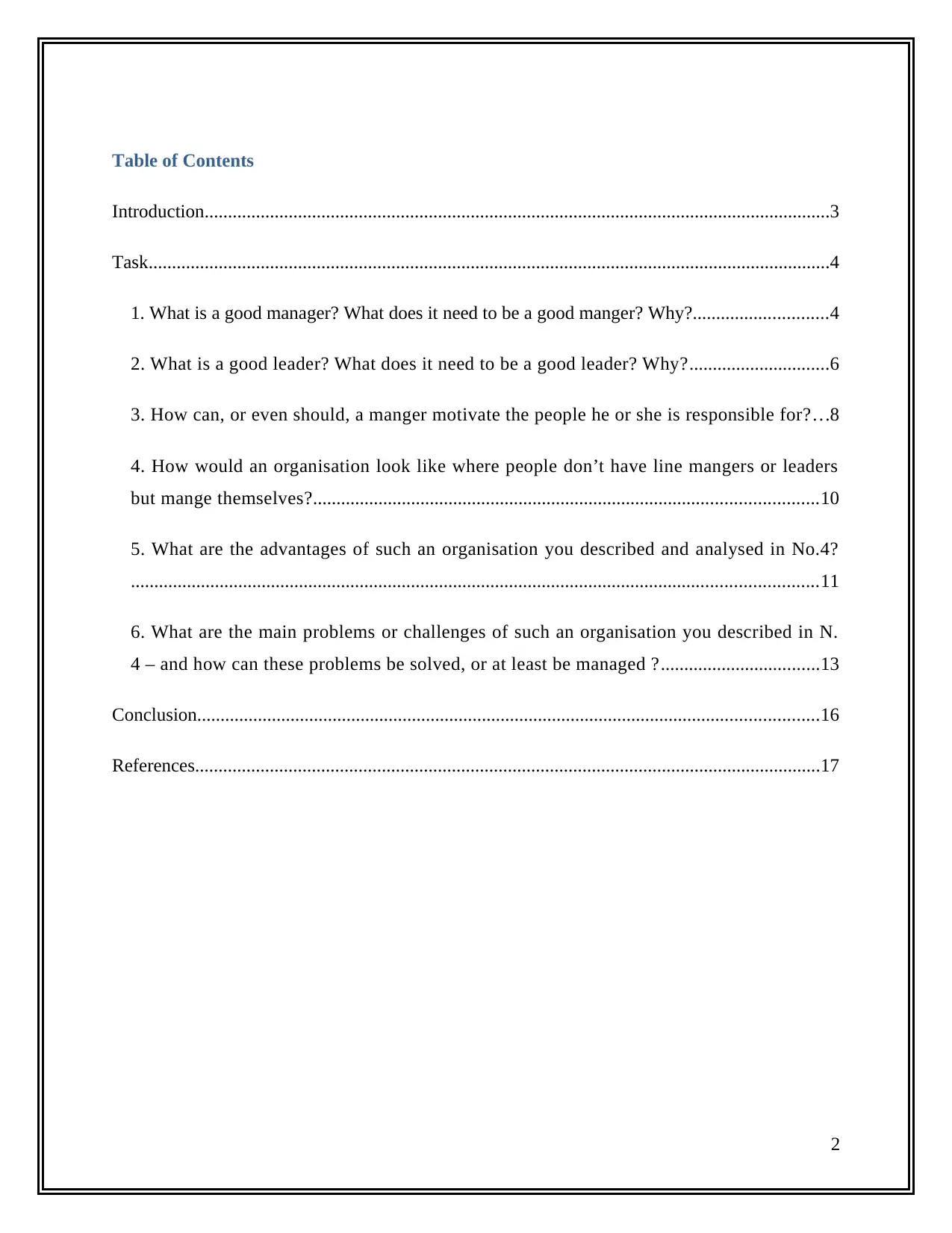
Table of Contents
Introduction......................................................................................................................................3
Task..................................................................................................................................................4
1. What is a good manager? What does it need to be a good manger? Why?.............................4
2. What is a good leader? What does it need to be a good leader? Why?..............................6
3. How can, or even should, a manger motivate the people he or she is responsible for?...8
4. How would an organisation look like where people don’t have line mangers or leaders
but mange themselves?............................................................................................................10
5. What are the advantages of such an organisation you described and analysed in No.4?
...................................................................................................................................................11
6. What are the main problems or challenges of such an organisation you described in N.
4 – and how can these problems be solved, or at least be managed ?..................................13
Conclusion.....................................................................................................................................16
References......................................................................................................................................17
2
Introduction......................................................................................................................................3
Task..................................................................................................................................................4
1. What is a good manager? What does it need to be a good manger? Why?.............................4
2. What is a good leader? What does it need to be a good leader? Why?..............................6
3. How can, or even should, a manger motivate the people he or she is responsible for?...8
4. How would an organisation look like where people don’t have line mangers or leaders
but mange themselves?............................................................................................................10
5. What are the advantages of such an organisation you described and analysed in No.4?
...................................................................................................................................................11
6. What are the main problems or challenges of such an organisation you described in N.
4 – and how can these problems be solved, or at least be managed ?..................................13
Conclusion.....................................................................................................................................16
References......................................................................................................................................17
2
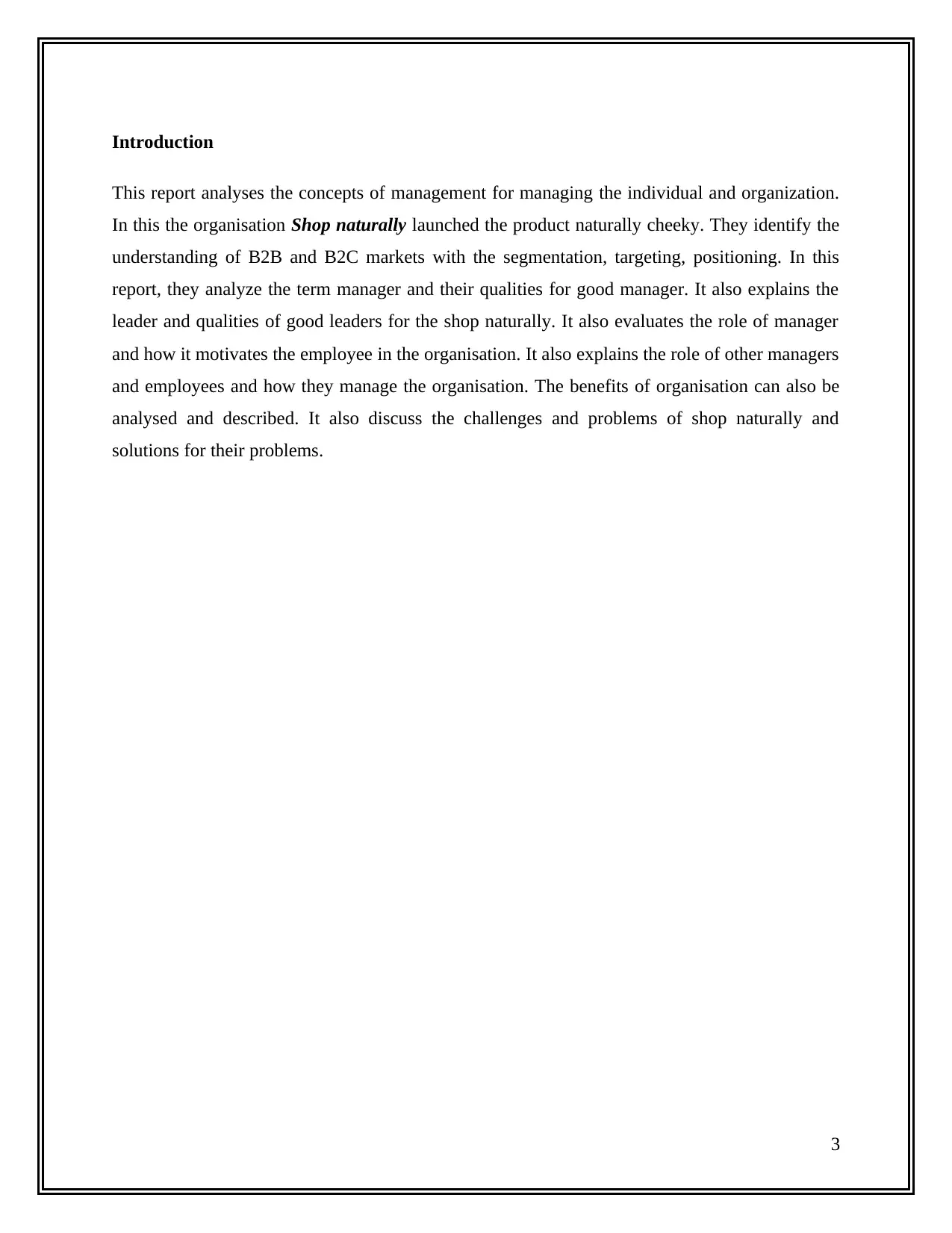
Introduction
This report analyses the concepts of management for managing the individual and organization.
In this the organisation Shop naturally launched the product naturally cheeky. They identify the
understanding of B2B and B2C markets with the segmentation, targeting, positioning. In this
report, they analyze the term manager and their qualities for good manager. It also explains the
leader and qualities of good leaders for the shop naturally. It also evaluates the role of manager
and how it motivates the employee in the organisation. It also explains the role of other managers
and employees and how they manage the organisation. The benefits of organisation can also be
analysed and described. It also discuss the challenges and problems of shop naturally and
solutions for their problems.
3
This report analyses the concepts of management for managing the individual and organization.
In this the organisation Shop naturally launched the product naturally cheeky. They identify the
understanding of B2B and B2C markets with the segmentation, targeting, positioning. In this
report, they analyze the term manager and their qualities for good manager. It also explains the
leader and qualities of good leaders for the shop naturally. It also evaluates the role of manager
and how it motivates the employee in the organisation. It also explains the role of other managers
and employees and how they manage the organisation. The benefits of organisation can also be
analysed and described. It also discuss the challenges and problems of shop naturally and
solutions for their problems.
3
⊘ This is a preview!⊘
Do you want full access?
Subscribe today to unlock all pages.

Trusted by 1+ million students worldwide
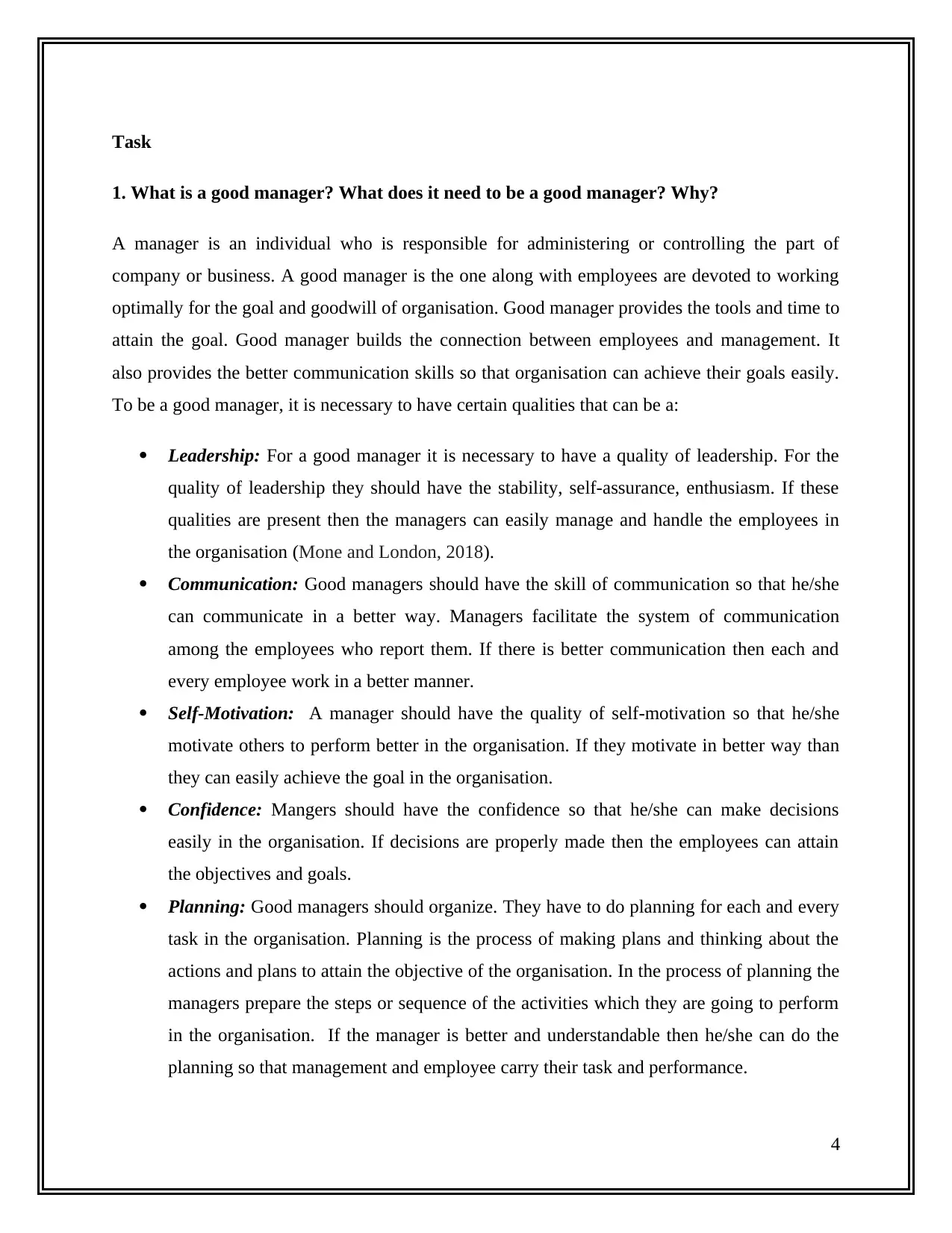
Task
1. What is a good manager? What does it need to be a good manager? Why?
A manager is an individual who is responsible for administering or controlling the part of
company or business. A good manager is the one along with employees are devoted to working
optimally for the goal and goodwill of organisation. Good manager provides the tools and time to
attain the goal. Good manager builds the connection between employees and management. It
also provides the better communication skills so that organisation can achieve their goals easily.
To be a good manager, it is necessary to have certain qualities that can be a:
Leadership: For a good manager it is necessary to have a quality of leadership. For the
quality of leadership they should have the stability, self-assurance, enthusiasm. If these
qualities are present then the managers can easily manage and handle the employees in
the organisation (Mone and London, 2018).
Communication: Good managers should have the skill of communication so that he/she
can communicate in a better way. Managers facilitate the system of communication
among the employees who report them. If there is better communication then each and
every employee work in a better manner.
Self-Motivation: A manager should have the quality of self-motivation so that he/she
motivate others to perform better in the organisation. If they motivate in better way than
they can easily achieve the goal in the organisation.
Confidence: Mangers should have the confidence so that he/she can make decisions
easily in the organisation. If decisions are properly made then the employees can attain
the objectives and goals.
Planning: Good managers should organize. They have to do planning for each and every
task in the organisation. Planning is the process of making plans and thinking about the
actions and plans to attain the objective of the organisation. In the process of planning the
managers prepare the steps or sequence of the activities which they are going to perform
in the organisation. If the manager is better and understandable then he/she can do the
planning so that management and employee carry their task and performance.
4
1. What is a good manager? What does it need to be a good manager? Why?
A manager is an individual who is responsible for administering or controlling the part of
company or business. A good manager is the one along with employees are devoted to working
optimally for the goal and goodwill of organisation. Good manager provides the tools and time to
attain the goal. Good manager builds the connection between employees and management. It
also provides the better communication skills so that organisation can achieve their goals easily.
To be a good manager, it is necessary to have certain qualities that can be a:
Leadership: For a good manager it is necessary to have a quality of leadership. For the
quality of leadership they should have the stability, self-assurance, enthusiasm. If these
qualities are present then the managers can easily manage and handle the employees in
the organisation (Mone and London, 2018).
Communication: Good managers should have the skill of communication so that he/she
can communicate in a better way. Managers facilitate the system of communication
among the employees who report them. If there is better communication then each and
every employee work in a better manner.
Self-Motivation: A manager should have the quality of self-motivation so that he/she
motivate others to perform better in the organisation. If they motivate in better way than
they can easily achieve the goal in the organisation.
Confidence: Mangers should have the confidence so that he/she can make decisions
easily in the organisation. If decisions are properly made then the employees can attain
the objectives and goals.
Planning: Good managers should organize. They have to do planning for each and every
task in the organisation. Planning is the process of making plans and thinking about the
actions and plans to attain the objective of the organisation. In the process of planning the
managers prepare the steps or sequence of the activities which they are going to perform
in the organisation. If the manager is better and understandable then he/she can do the
planning so that management and employee carry their task and performance.
4
Paraphrase This Document
Need a fresh take? Get an instant paraphrase of this document with our AI Paraphraser
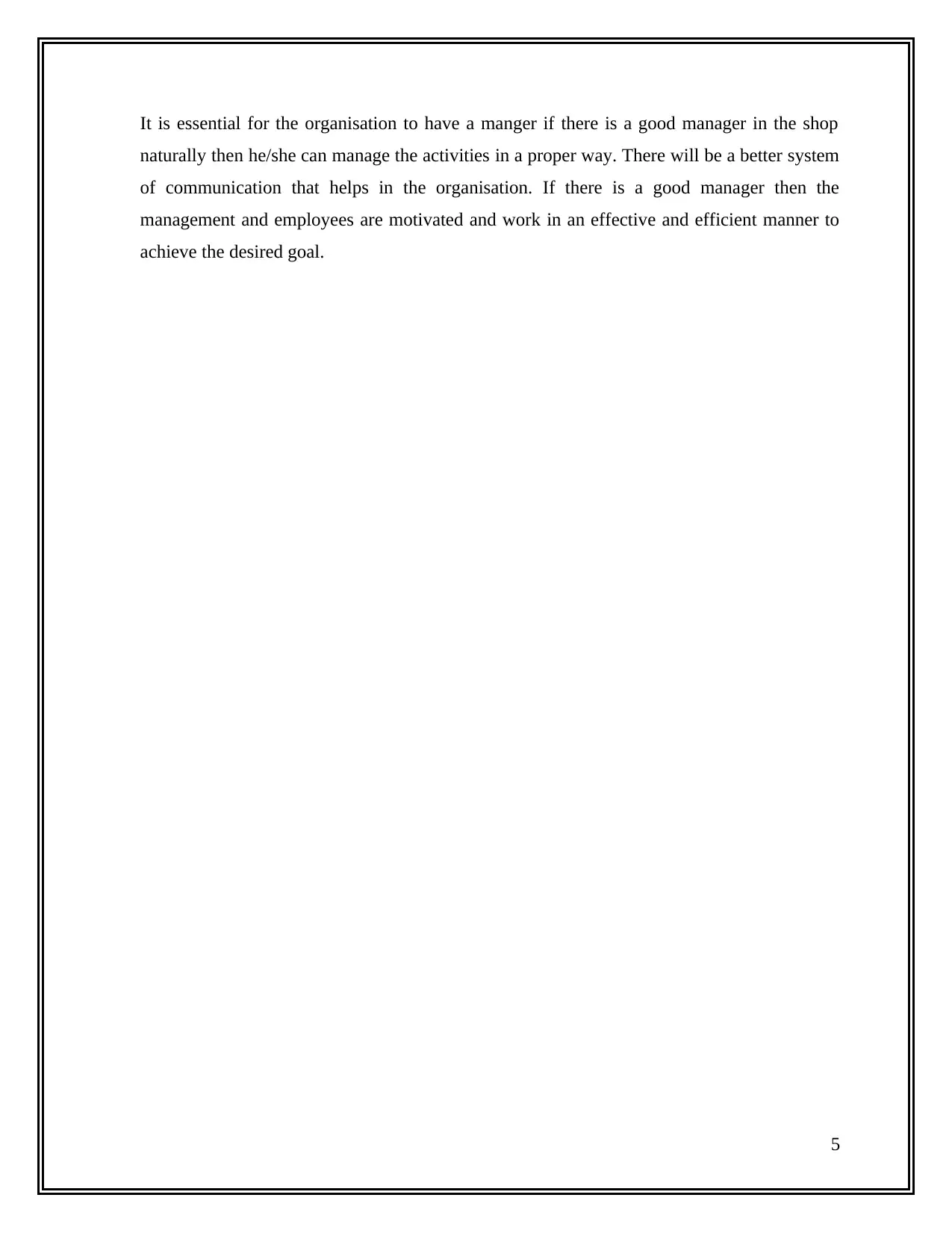
It is essential for the organisation to have a manger if there is a good manager in the shop
naturally then he/she can manage the activities in a proper way. There will be a better system
of communication that helps in the organisation. If there is a good manager then the
management and employees are motivated and work in an effective and efficient manner to
achieve the desired goal.
5
naturally then he/she can manage the activities in a proper way. There will be a better system
of communication that helps in the organisation. If there is a good manager then the
management and employees are motivated and work in an effective and efficient manner to
achieve the desired goal.
5
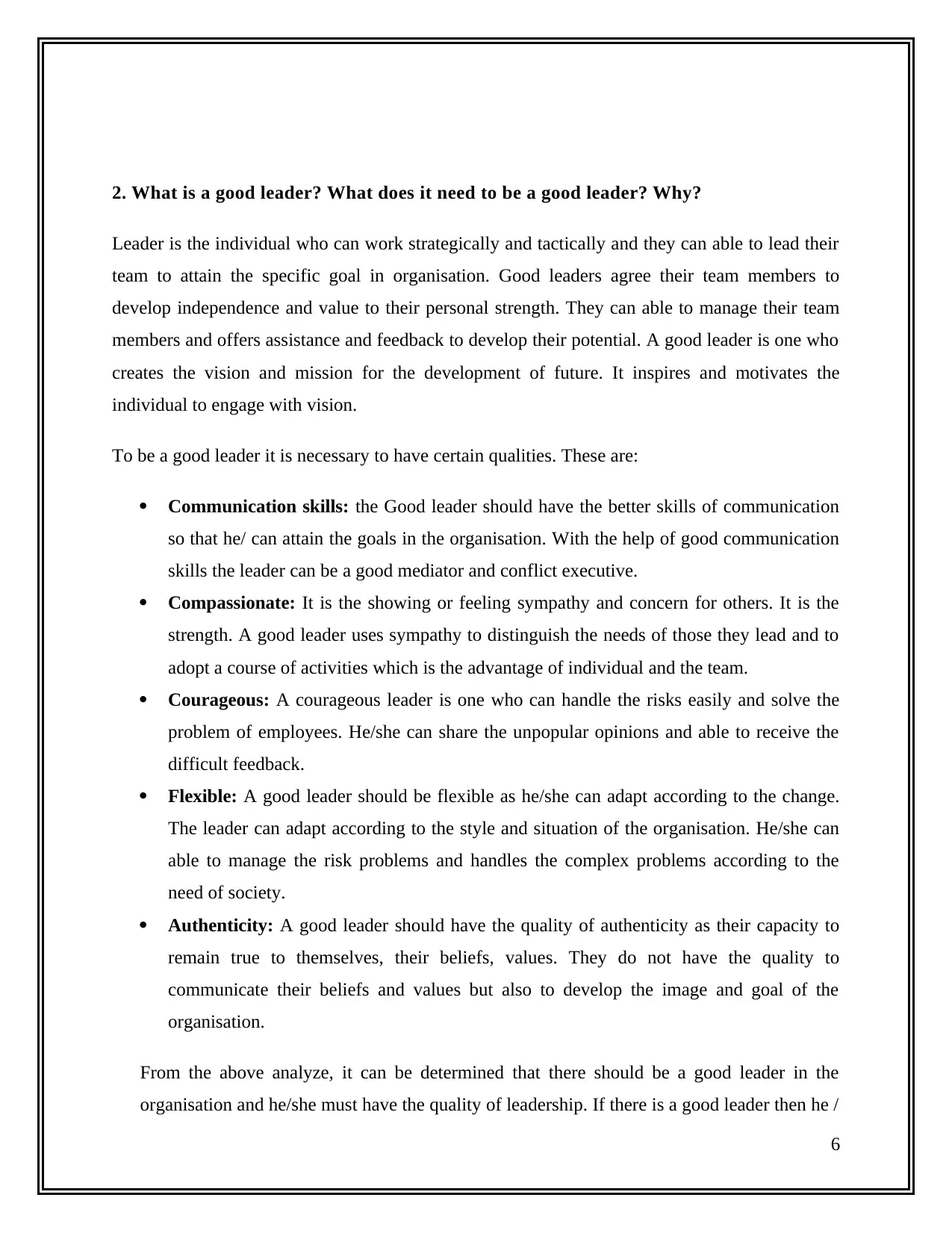
2. What is a good leader? What does it need to be a good leader? Why?
Leader is the individual who can work strategically and tactically and they can able to lead their
team to attain the specific goal in organisation. Good leaders agree their team members to
develop independence and value to their personal strength. They can able to manage their team
members and offers assistance and feedback to develop their potential. A good leader is one who
creates the vision and mission for the development of future. It inspires and motivates the
individual to engage with vision.
To be a good leader it is necessary to have certain qualities. These are:
Communication skills: the Good leader should have the better skills of communication
so that he/ can attain the goals in the organisation. With the help of good communication
skills the leader can be a good mediator and conflict executive.
Compassionate: It is the showing or feeling sympathy and concern for others. It is the
strength. A good leader uses sympathy to distinguish the needs of those they lead and to
adopt a course of activities which is the advantage of individual and the team.
Courageous: A courageous leader is one who can handle the risks easily and solve the
problem of employees. He/she can share the unpopular opinions and able to receive the
difficult feedback.
Flexible: A good leader should be flexible as he/she can adapt according to the change.
The leader can adapt according to the style and situation of the organisation. He/she can
able to manage the risk problems and handles the complex problems according to the
need of society.
Authenticity: A good leader should have the quality of authenticity as their capacity to
remain true to themselves, their beliefs, values. They do not have the quality to
communicate their beliefs and values but also to develop the image and goal of the
organisation.
From the above analyze, it can be determined that there should be a good leader in the
organisation and he/she must have the quality of leadership. If there is a good leader then he /
6
Leader is the individual who can work strategically and tactically and they can able to lead their
team to attain the specific goal in organisation. Good leaders agree their team members to
develop independence and value to their personal strength. They can able to manage their team
members and offers assistance and feedback to develop their potential. A good leader is one who
creates the vision and mission for the development of future. It inspires and motivates the
individual to engage with vision.
To be a good leader it is necessary to have certain qualities. These are:
Communication skills: the Good leader should have the better skills of communication
so that he/ can attain the goals in the organisation. With the help of good communication
skills the leader can be a good mediator and conflict executive.
Compassionate: It is the showing or feeling sympathy and concern for others. It is the
strength. A good leader uses sympathy to distinguish the needs of those they lead and to
adopt a course of activities which is the advantage of individual and the team.
Courageous: A courageous leader is one who can handle the risks easily and solve the
problem of employees. He/she can share the unpopular opinions and able to receive the
difficult feedback.
Flexible: A good leader should be flexible as he/she can adapt according to the change.
The leader can adapt according to the style and situation of the organisation. He/she can
able to manage the risk problems and handles the complex problems according to the
need of society.
Authenticity: A good leader should have the quality of authenticity as their capacity to
remain true to themselves, their beliefs, values. They do not have the quality to
communicate their beliefs and values but also to develop the image and goal of the
organisation.
From the above analyze, it can be determined that there should be a good leader in the
organisation and he/she must have the quality of leadership. If there is a good leader then he /
6
⊘ This is a preview!⊘
Do you want full access?
Subscribe today to unlock all pages.

Trusted by 1+ million students worldwide
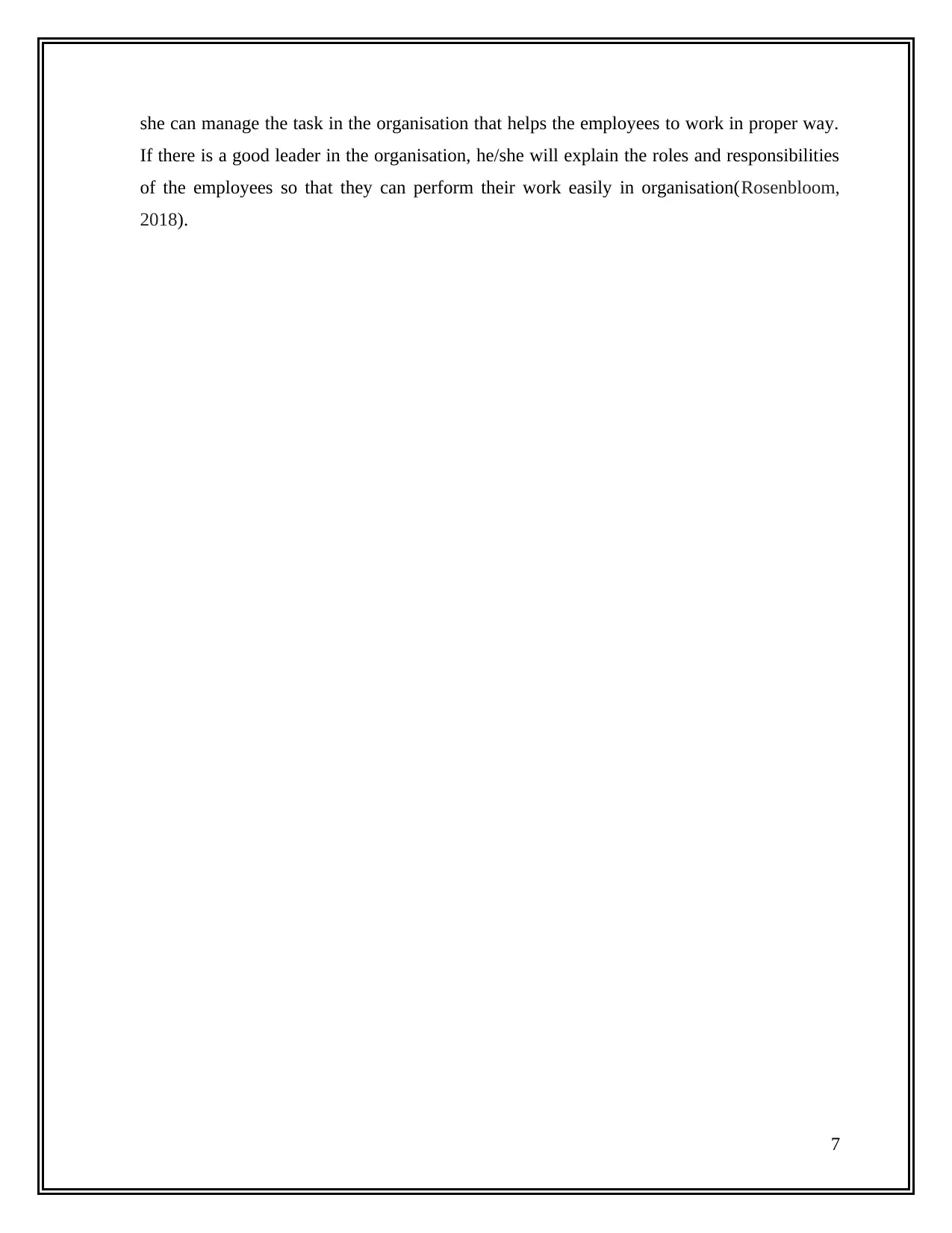
she can manage the task in the organisation that helps the employees to work in proper way.
If there is a good leader in the organisation, he/she will explain the roles and responsibilities
of the employees so that they can perform their work easily in organisation(Rosenbloom,
2018).
7
If there is a good leader in the organisation, he/she will explain the roles and responsibilities
of the employees so that they can perform their work easily in organisation(Rosenbloom,
2018).
7
Paraphrase This Document
Need a fresh take? Get an instant paraphrase of this document with our AI Paraphraser
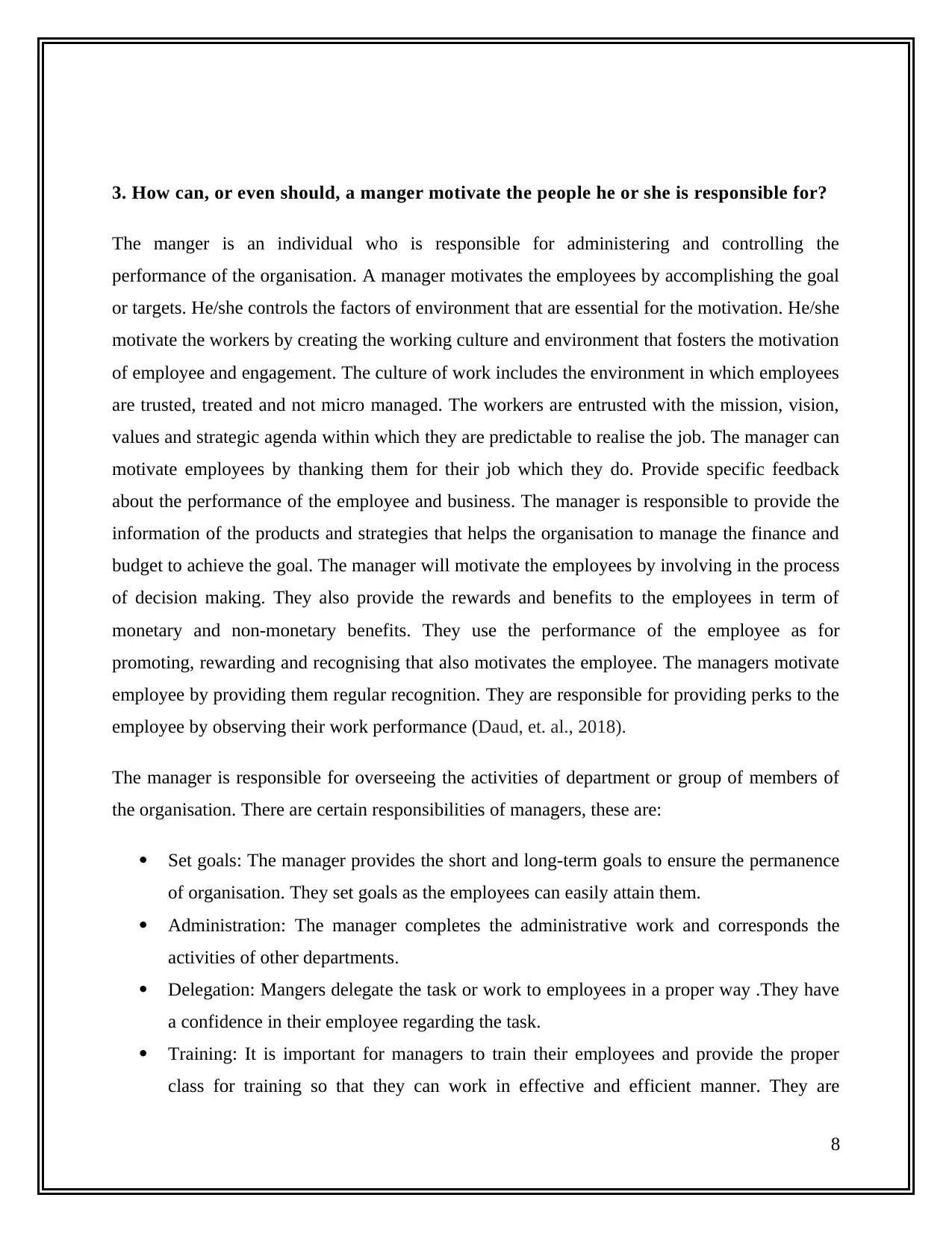
3. How can, or even should, a manger motivate the people he or she is responsible for?
The manger is an individual who is responsible for administering and controlling the
performance of the organisation. A manager motivates the employees by accomplishing the goal
or targets. He/she controls the factors of environment that are essential for the motivation. He/she
motivate the workers by creating the working culture and environment that fosters the motivation
of employee and engagement. The culture of work includes the environment in which employees
are trusted, treated and not micro managed. The workers are entrusted with the mission, vision,
values and strategic agenda within which they are predictable to realise the job. The manager can
motivate employees by thanking them for their job which they do. Provide specific feedback
about the performance of the employee and business. The manager is responsible to provide the
information of the products and strategies that helps the organisation to manage the finance and
budget to achieve the goal. The manager will motivate the employees by involving in the process
of decision making. They also provide the rewards and benefits to the employees in term of
monetary and non-monetary benefits. They use the performance of the employee as for
promoting, rewarding and recognising that also motivates the employee. The managers motivate
employee by providing them regular recognition. They are responsible for providing perks to the
employee by observing their work performance (Daud, et. al., 2018).
The manager is responsible for overseeing the activities of department or group of members of
the organisation. There are certain responsibilities of managers, these are:
Set goals: The manager provides the short and long-term goals to ensure the permanence
of organisation. They set goals as the employees can easily attain them.
Administration: The manager completes the administrative work and corresponds the
activities of other departments.
Delegation: Mangers delegate the task or work to employees in a proper way .They have
a confidence in their employee regarding the task.
Training: It is important for managers to train their employees and provide the proper
class for training so that they can work in effective and efficient manner. They are
8
The manger is an individual who is responsible for administering and controlling the
performance of the organisation. A manager motivates the employees by accomplishing the goal
or targets. He/she controls the factors of environment that are essential for the motivation. He/she
motivate the workers by creating the working culture and environment that fosters the motivation
of employee and engagement. The culture of work includes the environment in which employees
are trusted, treated and not micro managed. The workers are entrusted with the mission, vision,
values and strategic agenda within which they are predictable to realise the job. The manager can
motivate employees by thanking them for their job which they do. Provide specific feedback
about the performance of the employee and business. The manager is responsible to provide the
information of the products and strategies that helps the organisation to manage the finance and
budget to achieve the goal. The manager will motivate the employees by involving in the process
of decision making. They also provide the rewards and benefits to the employees in term of
monetary and non-monetary benefits. They use the performance of the employee as for
promoting, rewarding and recognising that also motivates the employee. The managers motivate
employee by providing them regular recognition. They are responsible for providing perks to the
employee by observing their work performance (Daud, et. al., 2018).
The manager is responsible for overseeing the activities of department or group of members of
the organisation. There are certain responsibilities of managers, these are:
Set goals: The manager provides the short and long-term goals to ensure the permanence
of organisation. They set goals as the employees can easily attain them.
Administration: The manager completes the administrative work and corresponds the
activities of other departments.
Delegation: Mangers delegate the task or work to employees in a proper way .They have
a confidence in their employee regarding the task.
Training: It is important for managers to train their employees and provide the proper
class for training so that they can work in effective and efficient manner. They are
8
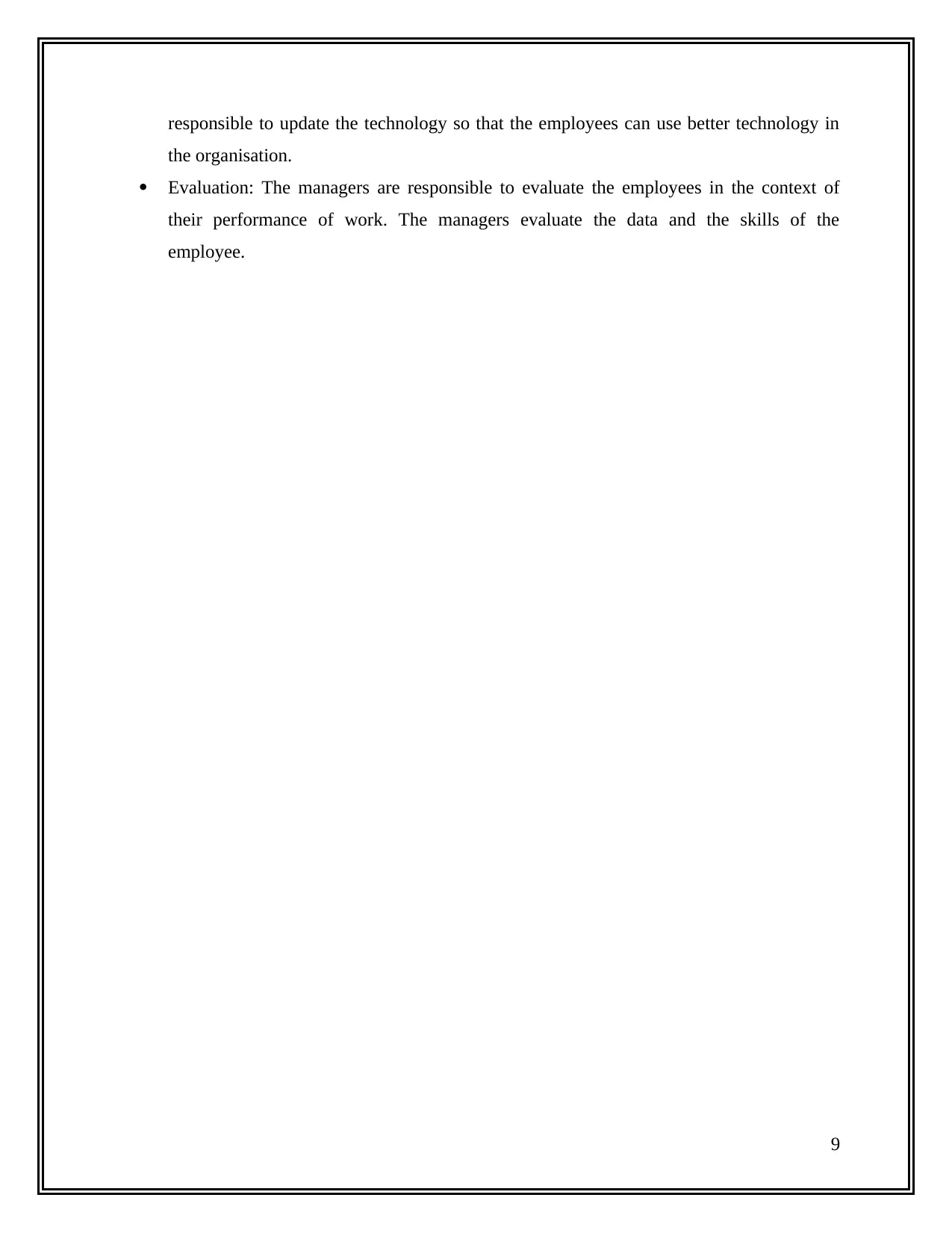
responsible to update the technology so that the employees can use better technology in
the organisation.
Evaluation: The managers are responsible to evaluate the employees in the context of
their performance of work. The managers evaluate the data and the skills of the
employee.
9
the organisation.
Evaluation: The managers are responsible to evaluate the employees in the context of
their performance of work. The managers evaluate the data and the skills of the
employee.
9
⊘ This is a preview!⊘
Do you want full access?
Subscribe today to unlock all pages.

Trusted by 1+ million students worldwide
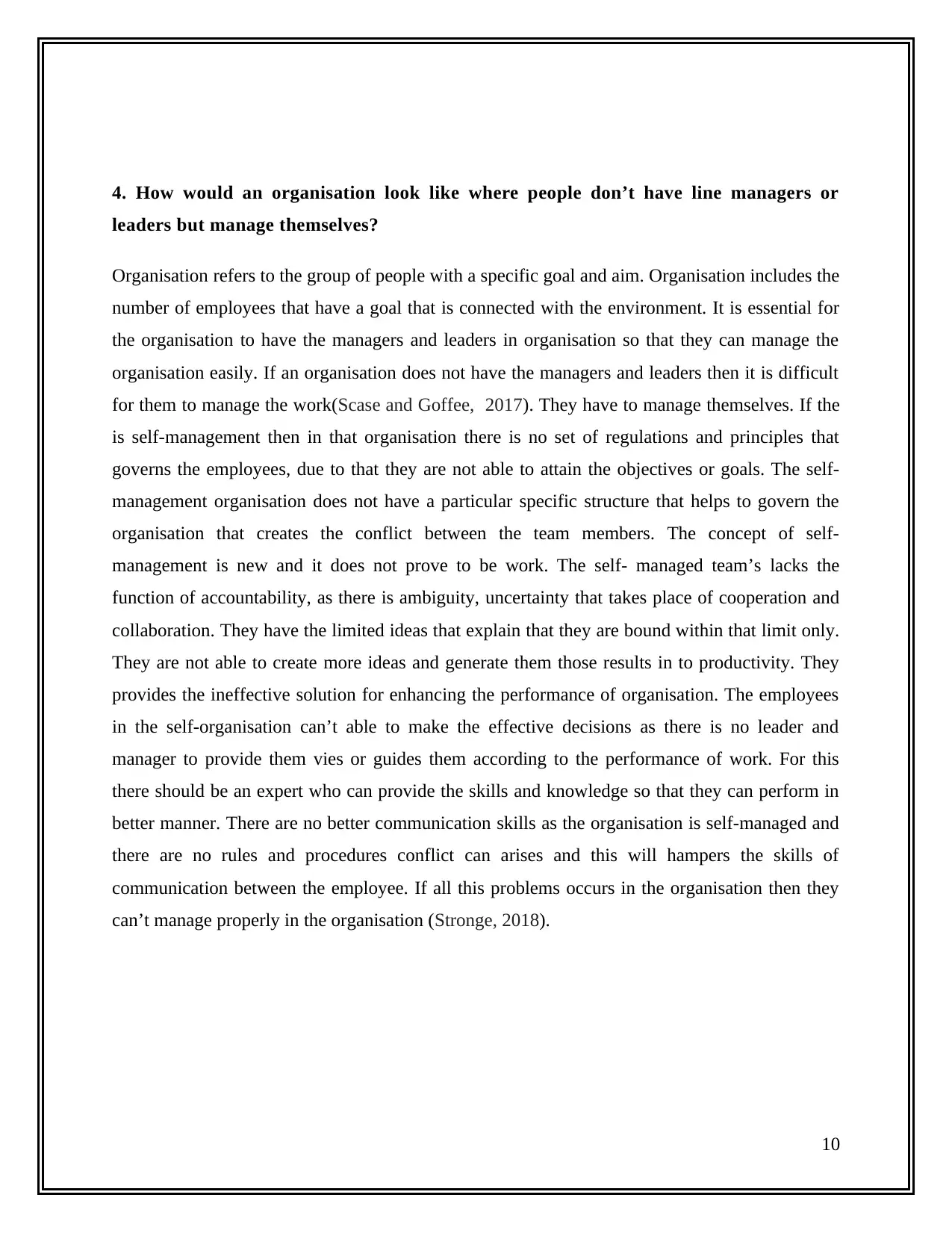
4. How would an organisation look like where people don’t have line managers or
leaders but manage themselves?
Organisation refers to the group of people with a specific goal and aim. Organisation includes the
number of employees that have a goal that is connected with the environment. It is essential for
the organisation to have the managers and leaders in organisation so that they can manage the
organisation easily. If an organisation does not have the managers and leaders then it is difficult
for them to manage the work(Scase and Goffee, 2017). They have to manage themselves. If the
is self-management then in that organisation there is no set of regulations and principles that
governs the employees, due to that they are not able to attain the objectives or goals. The self-
management organisation does not have a particular specific structure that helps to govern the
organisation that creates the conflict between the team members. The concept of self-
management is new and it does not prove to be work. The self- managed team’s lacks the
function of accountability, as there is ambiguity, uncertainty that takes place of cooperation and
collaboration. They have the limited ideas that explain that they are bound within that limit only.
They are not able to create more ideas and generate them those results in to productivity. They
provides the ineffective solution for enhancing the performance of organisation. The employees
in the self-organisation can’t able to make the effective decisions as there is no leader and
manager to provide them vies or guides them according to the performance of work. For this
there should be an expert who can provide the skills and knowledge so that they can perform in
better manner. There are no better communication skills as the organisation is self-managed and
there are no rules and procedures conflict can arises and this will hampers the skills of
communication between the employee. If all this problems occurs in the organisation then they
can’t manage properly in the organisation (Stronge, 2018).
10
leaders but manage themselves?
Organisation refers to the group of people with a specific goal and aim. Organisation includes the
number of employees that have a goal that is connected with the environment. It is essential for
the organisation to have the managers and leaders in organisation so that they can manage the
organisation easily. If an organisation does not have the managers and leaders then it is difficult
for them to manage the work(Scase and Goffee, 2017). They have to manage themselves. If the
is self-management then in that organisation there is no set of regulations and principles that
governs the employees, due to that they are not able to attain the objectives or goals. The self-
management organisation does not have a particular specific structure that helps to govern the
organisation that creates the conflict between the team members. The concept of self-
management is new and it does not prove to be work. The self- managed team’s lacks the
function of accountability, as there is ambiguity, uncertainty that takes place of cooperation and
collaboration. They have the limited ideas that explain that they are bound within that limit only.
They are not able to create more ideas and generate them those results in to productivity. They
provides the ineffective solution for enhancing the performance of organisation. The employees
in the self-organisation can’t able to make the effective decisions as there is no leader and
manager to provide them vies or guides them according to the performance of work. For this
there should be an expert who can provide the skills and knowledge so that they can perform in
better manner. There are no better communication skills as the organisation is self-managed and
there are no rules and procedures conflict can arises and this will hampers the skills of
communication between the employee. If all this problems occurs in the organisation then they
can’t manage properly in the organisation (Stronge, 2018).
10
Paraphrase This Document
Need a fresh take? Get an instant paraphrase of this document with our AI Paraphraser
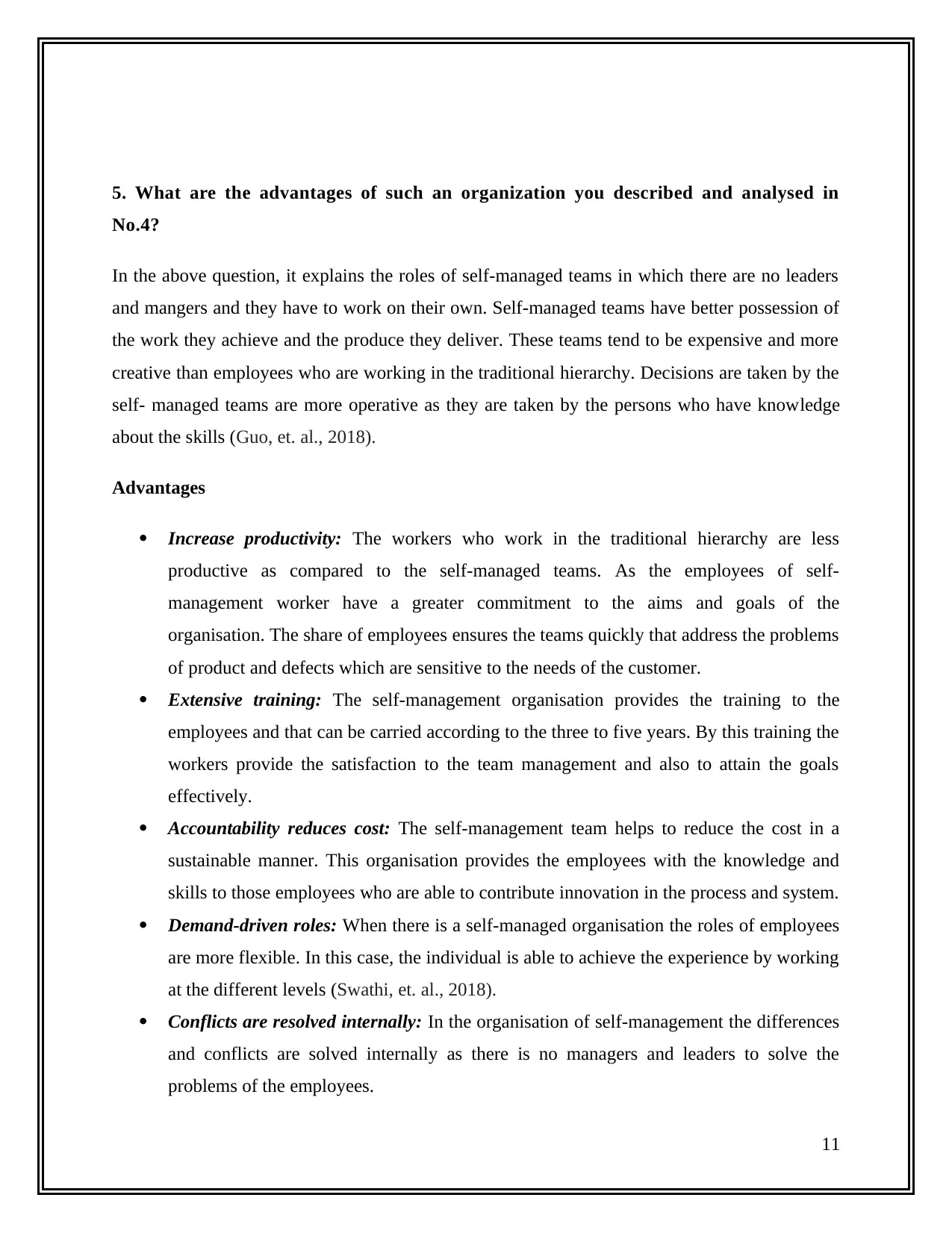
5. What are the advantages of such an organization you described and analysed in
No.4?
In the above question, it explains the roles of self-managed teams in which there are no leaders
and mangers and they have to work on their own. Self-managed teams have better possession of
the work they achieve and the produce they deliver. These teams tend to be expensive and more
creative than employees who are working in the traditional hierarchy. Decisions are taken by the
self- managed teams are more operative as they are taken by the persons who have knowledge
about the skills (Guo, et. al., 2018).
Advantages
Increase productivity: The workers who work in the traditional hierarchy are less
productive as compared to the self-managed teams. As the employees of self-
management worker have a greater commitment to the aims and goals of the
organisation. The share of employees ensures the teams quickly that address the problems
of product and defects which are sensitive to the needs of the customer.
Extensive training: The self-management organisation provides the training to the
employees and that can be carried according to the three to five years. By this training the
workers provide the satisfaction to the team management and also to attain the goals
effectively.
Accountability reduces cost: The self-management team helps to reduce the cost in a
sustainable manner. This organisation provides the employees with the knowledge and
skills to those employees who are able to contribute innovation in the process and system.
Demand-driven roles: When there is a self-managed organisation the roles of employees
are more flexible. In this case, the individual is able to achieve the experience by working
at the different levels (Swathi, et. al., 2018).
Conflicts are resolved internally: In the organisation of self-management the differences
and conflicts are solved internally as there is no managers and leaders to solve the
problems of the employees.
11
No.4?
In the above question, it explains the roles of self-managed teams in which there are no leaders
and mangers and they have to work on their own. Self-managed teams have better possession of
the work they achieve and the produce they deliver. These teams tend to be expensive and more
creative than employees who are working in the traditional hierarchy. Decisions are taken by the
self- managed teams are more operative as they are taken by the persons who have knowledge
about the skills (Guo, et. al., 2018).
Advantages
Increase productivity: The workers who work in the traditional hierarchy are less
productive as compared to the self-managed teams. As the employees of self-
management worker have a greater commitment to the aims and goals of the
organisation. The share of employees ensures the teams quickly that address the problems
of product and defects which are sensitive to the needs of the customer.
Extensive training: The self-management organisation provides the training to the
employees and that can be carried according to the three to five years. By this training the
workers provide the satisfaction to the team management and also to attain the goals
effectively.
Accountability reduces cost: The self-management team helps to reduce the cost in a
sustainable manner. This organisation provides the employees with the knowledge and
skills to those employees who are able to contribute innovation in the process and system.
Demand-driven roles: When there is a self-managed organisation the roles of employees
are more flexible. In this case, the individual is able to achieve the experience by working
at the different levels (Swathi, et. al., 2018).
Conflicts are resolved internally: In the organisation of self-management the differences
and conflicts are solved internally as there is no managers and leaders to solve the
problems of the employees.
11
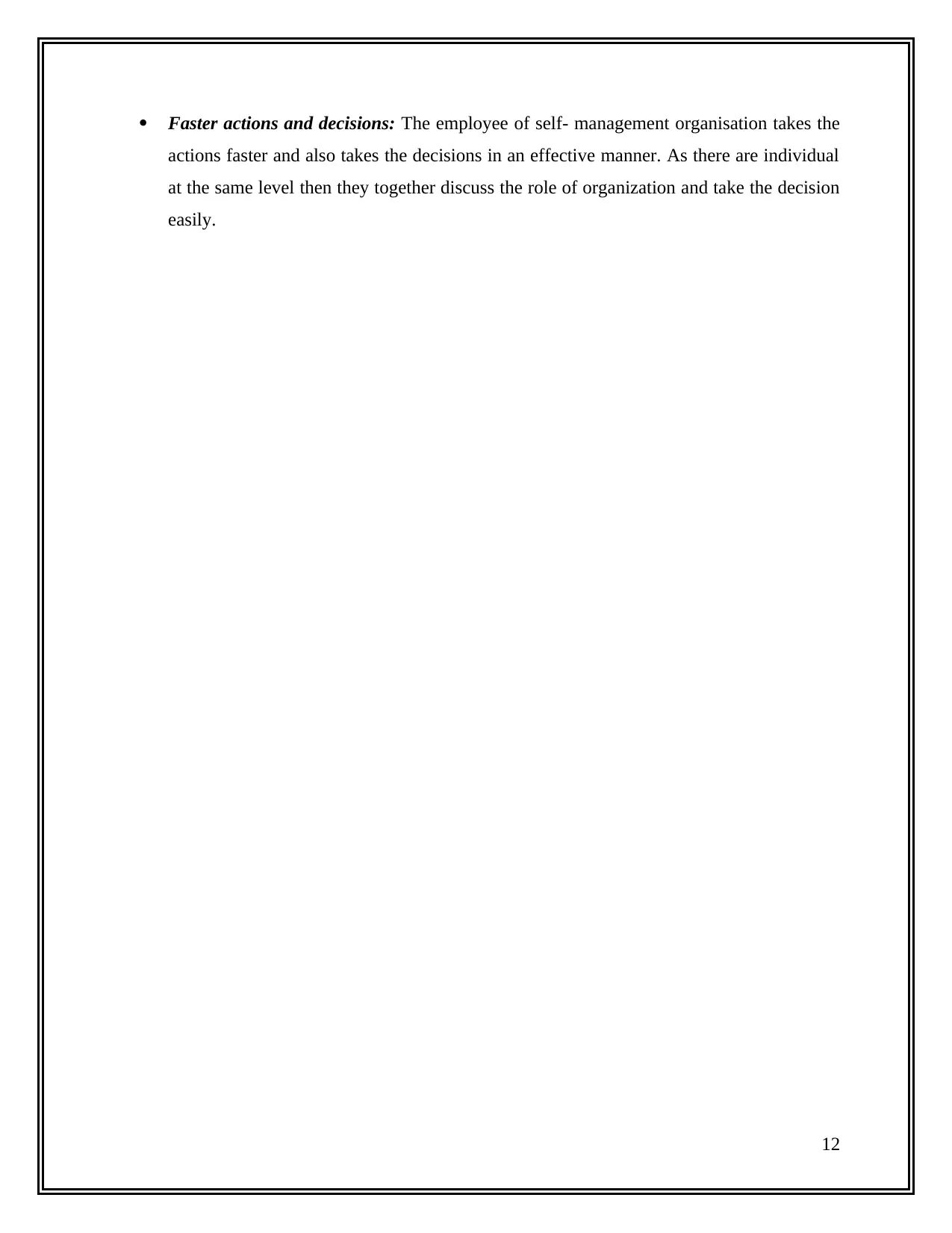
Faster actions and decisions: The employee of self- management organisation takes the
actions faster and also takes the decisions in an effective manner. As there are individual
at the same level then they together discuss the role of organization and take the decision
easily.
12
actions faster and also takes the decisions in an effective manner. As there are individual
at the same level then they together discuss the role of organization and take the decision
easily.
12
⊘ This is a preview!⊘
Do you want full access?
Subscribe today to unlock all pages.

Trusted by 1+ million students worldwide
1 out of 17
Related Documents
Your All-in-One AI-Powered Toolkit for Academic Success.
+13062052269
info@desklib.com
Available 24*7 on WhatsApp / Email
![[object Object]](/_next/static/media/star-bottom.7253800d.svg)
Unlock your academic potential
Copyright © 2020–2025 A2Z Services. All Rights Reserved. Developed and managed by ZUCOL.





